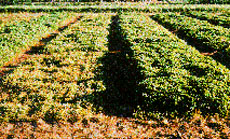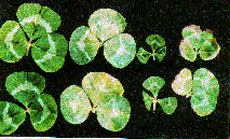
Part G - Establishing sub clover
Introducing a new sub clover variety
To introduce a new variety successfully:
- Reduce any oestrogenic or superseded sub clovers in the paddock to a low level (see Eradicating oestrogenic clover).
- Use a pre-emergence herbicide to ensure minimum competition from weeds.
- Buy only certified seed or seed produced under a seed company quality assurance scheme to ensure that you sow the variety required. Uncertified bags may be labelled inaccurately, and they may contain seed of oestrogenic clovers, weeds and other contaminants.
- Sow at a rate up to 7 kg/ha (10 kg/ha for irrigation). Use seed with a high germination percentage, and inoculate and lime pellet where necessary. Inoculation is necessary where sub clover has not been grown in the paddock for the last 5 years or where the soils are acid.
- Use at least 150 kg/ha of single superphosphate or its equivalent. Use molybdenum (Mo) as a seed dressing or in fortified superphosphate where required. Molybdenum is necessary for good sub clover development. Gypsum improves pasture establishment on sodic (high sodium) soils.
- Sow sub clover early (March–May) to allow plants to develop properly before they flower and set seed in spring.
- For best results use a band seeder and sow no deeper than 1.5 cm.
- Inspect young pastures carefully and control pests such as redlegged earth mites, sitona weevil and lucerne flea, particularly when pastures are in the seedling stage (see Part C Insect pests of sub clover).
- If spraying to control broadleaf weeds after sowing, use a herbicide that is safe for sub clover. Spray early when the weeds are small. Avoid spraying within 6 weeks of sub clover flowering.
- Inspect the sub clover again at flowering to check for redlegged earth mite, heliothis caterpillar and bluegreen aphid, which reduce seedset. Spray if necessary.
- Once seedlings are established, graze the young sub clover pasture moderately until it starts flowering. During flowering and seed production, graze sub clover lightly, as overgrazing will severely reduce seed yields.
Sowing with a companion crop
If sowing with a companion crop:
- Sow a short-strawed wheat, or sow barley, triticale or lupins, as a preferred companion crop. Do not use oats, as this crop tends to smother sub clover seedlings.
- Sow the cereal companion crop at a rate of 20 kg/ha or less in alternate runs of the combine, or at 15 kg/ha or less through every run of the combine. This low seeding rate reduces competition for light and moisture and will result in a better sub clover seedset.
- Where early growth of the companion crop is lush and leafy and is shading the pasture, graze lightly to reduce competition.
- After harvest, graze the paddock at a light to moderate rate. Heavy grazing may reduce the carryover of sub clover seed.
Where rainfall is erratic and the reliability of sub clover establishment is low, it can be beneficial to include a small amount of sub clover seed (2 kg/ha) every time the paddock is sown during the cropping phase. This allows sub clover seed reserves to be built up so that ‘false starts’ are less of a problem when the paddock is returned to the pasture phase.
Eradicating oestrogenic clover
A single pass of the plough does not eradicate oestrogenic clover. Under an old sub clover stand there may be up to 0.5 t/ha of ungerminated sub clover seed. Geraldton, Dwalganup and Yarloop are all moderately hard-seeded varieties, and seeds will germinate for up to 3 years after the seed was originally produced. Similarly, non-oestrogenic hard-seeded varieties should be reduced prior to introducing new cultivars.
This seed bank must be methodically reduced over several seasons. To achieve this, the unwanted oestrogenic clover must be controlled by cultivation or with herbicides, and the affected area sown to crop for 3–4 years. Every effort must be made to stop the oestrogenic clover from reseeding.
Controlling by cultivation
Plough unwanted sub clover pasture in late July or early August to stop it from seeding. Where this is not possible, graze the pasture heavily to keep it short throughout spring and so reduce seed production. During the following autumn, new seedlings will establish after each fall of rain. In some situations a light discing or harrowing to a depth of 2–3 cm may promote a greater level of germination by breaking the dormancy or hardseededness of the seed. These seedlings must be killed by cultivation or with herbicides. The paddock must then be cropped for 3–4 years.
Controlling with herbicides
Where reduced cultivation or direct drilling systems are practised, it may be desirable to use herbicides in preference to cultivation to stop the sub clover from seeding and to kill young seedlings. In this situation, spray the unwanted sub clover pasture with an appropriate herbicide in early to mid August or immediately it begins to flower. It is important to ensure that no strips are missed and that fencelines, dam banks, gateways and areas around trees are sprayed. Otherwise, clover plants (and therefore seeds) will be left in patches in the paddock. This could lead to a build-up of the unwanted oestrogenic sub clover in later years.
During the following autumn, new sub clover seedlings can be allowed to grow until shortly before sowing the crop. They can then be killed with an appropriate herbicide. Once again a light discing or harrowing to a depth of 2–3 cm during autumn will help promote a better germination. Spray again later in the season, even if there are no broadleaf weeds present, to ensure that any later germination of sub clover is killed. Repeat this procedure every year until the replacement sub clover is sown.
Cropping strategy
To minimise seedset of oestrogenic clovers, sow crops that allow the use of broadleaf herbicides and produce a dense, leafy canopy which smothers the clover.
Oats is a suitable first crop, particularly when used with new herbicides that give good general control of weeds (including unwanted sub clover). Oats produce a dense canopy that smothers the sub clover and has the further advantage that hormone herbicides can be used late in the season to control later germinations of clover.
A seeding rate of at least 70 kg/ha should be used with wheat or barley to achieve a dense stand capable of shading clover plants that have not been killed earlier by cultivation. Once again, it is important that any sub clover regenerating under the crop is killed with an appropriate herbicide.
Postharvest management
After harvesting the crop, do not move sheep from nearby oestrogenic clover pastures straight onto the stubble or fallow, as undigested sub clover seed in sheep droppings will contaminate the area. To avoid this problem, allow sheep to empty out in the sheep yards overnight before letting them in to graze the harvested area. Repeated cropping for at least 3 years, combined with control by cultivation or with herbicides, or both, will ensure that a minimum of residual seed is left in the soil. Take care that oestrogenic sub clovers are not reintroduced in hay brought onto the farm.
Farmers in southern NSW have found that a Dwalganup-dominant pasture can be successfully replaced with a stand of Nungarin sub clover, certifiable for seed production within 5 years.
Herbicides used on sub clover
Herbicide effects
Herbicides are an important tool in controlling weeds in pastures, but many broadleaf herbicides and some grass herbicides severely retard sub clover growth. This effect is most pronounced in winter, with most clover plants recovering in spring.
Herbicides differ in their residual effect, with hormone herbicides such as MCPA and 2,4-DB lasting much longer than contact herbicides. The effect of herbicides on sub clover varies with temperature, soil moisture and whether the clover is suffering from disease, such as root disease. To be most effective, herbicides should be applied early (autumn–winter), as late applications are less effective on weeds and may reduce seedset by the clover.
Cultivar tolerance
Sub clover cultivars vary in their tolerance to herbicides. Some cultivars are particularly sensitive to specific herbicides, for example Karridale is very sensitive to MCPA and Dalkeith is very sensitive to 2,4-DB. Cultivar maturity appears to be important, with seed production of early-maturing cultivars such as Dalkeith being more affected by herbicides due to the shorter recovery period between herbicide application and seed filling.
The plot below shows suppression in growth due to simazine. Herbicide toxicity will vary with environmental conditions.

Herbicide damage symptoms, from left to right:
- unsprayed
- bromoxynil
- MCPA
- MCPA + Igran

Effects on seedset
Removing weed competition using herbicides can be crucial to successful establishment of new clover stands. However, application when sub clover is close to flowering is more likely to depress clover seedset, particularly with hormone herbicides. To avoid suppressing seedset, apply herbicides at least 6 weeks prior to flowering. If applying herbicides close to flowering, do not use hormone herbicides, as they have a greater residual effect.
Spray-topping with low rates of glyphosate to control grass seedset can also reduce clover seedset. This practice should only be used where there are good reserves of clover seed in the soil or where the paddock is to be cropped in the following year.
Further information
For further information on subterranean clover, see the other sections of this Agfact:
- Part A Subterranean clover in New South Wales - identification and use
- Part B Diseases of sub clover
- Part C Insect pests of sub clover
- Part D Viruses in sub clover
- Part E Sub clover varieties and their identification
- Part F Choosing the right sub clover variety
ALWAYS READ THE LABEL
Users of agricultural (or veterinary) chemical products must always read the label and any Permit before using the product, and strictly comply with the directions on the label and the conditions of any Permit. Users are not absolved from compliance with the directions on the label or the conditions of the Permit by reason of any statement made or not made in this publication.
WARNING
Pesticide residues may accumulate in animals treated with any pesticide or fed any crop product, including crop residues, which have been sprayed with pesticides. In the absence of any specific grazing withholding period(s), grazing of any treated crop is at the owner's risk. Withholding periods for stock treated with any pesticide or fed on any pesticide treated plant matter must also be observed. Pesticide residues may also contaminate grains, oils and other plant products for human use and consumption. Growers should observe harvest withholding periods on the pesticide label and should not assume that in the absence of a withholding period or after the expiry of a withholding period that the plant will be free of pesticide residues.
PASTURE IMPROVEMENT CAUTIONS
Pasture improvement may be associated with an increase in the incidence of certain livestock health disorders. Livestock and production losses from some disorders is possible. Management may need to be modified to minimise risk. Consult your veterinarian or adviser when planning pasture improvement.
Current conservation legislation may restrict some pasture improvement practices where existing pasture contains native species. Inquire through your office of the Department of Infrastructure, Planning and Natural Resources for further details.

